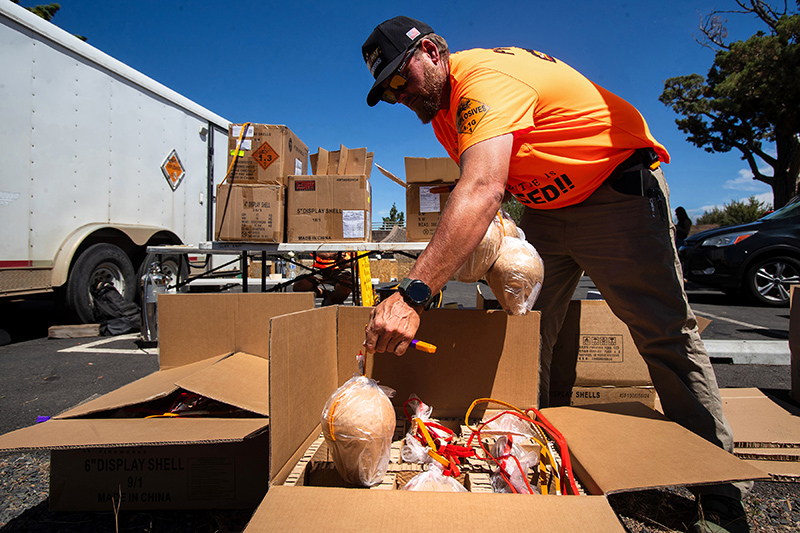For true madness in March, check out the NAIA
Published 12:00 am Monday, March 19, 2018

- Langston University players celebrate a victory during the NAIA Division I basketball tournament at Municipal Auditorium in Kansas City, Missouri, on March 15, 2017. (Christopher Smith/The New York Times)
KANSAS CITY, Mo. — One by one, the teams marched onto the court, lining up in rows until they had filled half the floor from baseline to midcourt, roughly 500 men’s college basketball players, coaches and team managers standing shoulder to shoulder.
The unusual display of hoops humanity is known as the Parade of Champions, and it is a signature moment at the annual NAIA Basketball Championship, one of the wildest events in college sports.
Many call the more popular — and more lucrative — 68-team NCAA men’s basketball tournament “madness.” But compared with the NAIA event, that is just a three-week, 14-city corporate show. The NAIA’s version is truly nuts: 32 teams, seven days and one shared hotel. It is a virtual assembly line of college basketball, and for the true hoops fanatic it is basketball paradise.
“This is the real March Madness,” Larry Cordaro, coach of Louisiana State-Alexandria, said during a busy breakfast Thursday at The Westin Kansas City, where all 32 teams were quartered.
It was a little after 9 a.m. when Cordaro spoke, on the tournament’s second day, and already there was a game in progress at the nearby Municipal Auditorium, the venerable art deco treasure that housed the first National Association of Intercollegiate Athletics tournament in 1937. That was a year before the first NIT and two years before the NCAA held its inaugural event.
The NAIA long ago surrendered its primacy in college basketball, and it now exists beyond the NCAA’s three divisions, as a sort of fourth tier in college sports, a collection of small colleges and directional schools with names like Peru State, Central Methodist and Our Lady of the Lake. But even with its reduced stature, the NAIA’s annual tournament remains something special.
Thursday’s first game, like all the rest, was live-streamed back to the Westin’s lobby, and about 20 players and coaches from various teams paused to watch before or after their breakfasts. A few feet away in a corner of the restaurant, Cordaro, whose Generals won their first-round game the day before, wolfed down a plate of eggs as he negotiated with the head waiter for a time slot to feed his team.
With 450 players filtering through each morning, “I’m just fighting to get breakfast time,” Cordaro said.
Court time can be even harder to arrange. In the event’s hectic first three days, there are 24 games with breaks of only 10 minutes between each, and no one can practice in the arena. That makes court time so precious that some teams do their layup drills during the 10-minute halftimes of the games that precede their own, a delicate dance that sometimes creates a logjam of four teams on the court at once — two walking off and two more coming back on.
On Wednesday, the first day of the event, the games stretched over almost 16 hours, from the first tip at 9 a.m. to the last buzzer at almost 1 a.m. Thursday. Cordaro’s team, which drove 13 hours from Louisiana crammed into a single minibus, won despite seeing one of its best players, dynamic forward Brandon Moss, miss a circus dunk attempt on a breakaway with five minutes left in a two-possession game. Cordaro, not for the first time, was left shaking his head.
The NAIA consists of 94 mostly small colleges and universities, many with enrollments of fewer than 2,000 students (its women’s basketball tournament is held concurrently in Billings, Montana). The teams display a wide variety of playing styles, ranging from conservative and disciplined teams to more freewheeling programs with something closer to a playground ethos.
During warm-ups before their first game, for example, some of the Louisiana State-Alexandria players worked on half-court shots. At the other end of the court, players from Idaho’s Lewis-Clark State practiced — and missed — several wild dunk attempts, the balls careening high into the air.
One of the most famous dunks in basketball history — Darryl Dawkins’ glass-shattering slam for the Philadelphia 76ers against the Kansas City Kings — happened at this 10,000-seat downtown arena in 1979, so dunking is a tradition here. The coaches did not seem fazed by the misses, but the NAIA Tournament is more about the players than the coaches, anyway, and most are brimming with confidence.
“I’m the best shooter in the country,” LSU-Shreveport guard Benjamin Batts declared in the driveway of the Westin, a boast that willfully ignored the fact that he does not even have the best shooting percentage on his team. Batts, a transfer from Texas Wesleyan, the defending NAIA champion, said his favorite part of the tournament was watching everyone else go home.
“It can get kind of awkward in the elevator when you’re riding with someone from the team you just beat,” he said. “You know, awkward for them. Not me.”
The high scorer in the first round was senior guard Ryan Imhoff of Montana’s Carroll College; his 30 points led the Saints over Lindsey Wilson College of Kentucky. A chemistry major, Imhoff may have the talent to play overseas professionally, but his ultimate goal, he said, is to be a pharmaceutical researcher, a career that will require a doctorate.
“Study and play basketball, that’s all I do,” he said as he prepared for Carroll’s next game. “There’s no downtime.”
The tournament was started in 1937 by basketball’s inventor, James Naismith, and others, when the NAIA was known as the National Association of Intercollegiate Basketball. This year is the 70th anniversary of Clarence Walker’s breaking the color barrier for all college basketball tournaments.
Today’s NAIA players might not be as big or as talented as many of their NCAA counterparts playing on bigger stages this week, but they celebrate buzzer-beating shots with the same raucous pileups as NCAA teams do, and they suffer the losses just as hard. By 10:30 a.m. of the first day, three players from William Carey of Mississippi, which lost to Georgia’s Life University by a point in the tournament’s first game, were sobbing on court.
“That 9 a.m. game is a real challenge,” said Bob Burchard, coach of Columbia College in Missouri, which lost its first-round game to Campbellsville of Kentucky on Thursday afternoon.
Burchard has coached at Columbia for 30 years, and he has the most wins of any current NAIA coach: 774. He has been coming to the tournament since the mid-1980s, when he was an assistant at Missouri Western State College. One year, he said, he watched in awe as a galloping coil of energy named Dennis Rodman scored 46 points and grabbed 32 rebounds in a game for Southeastern Oklahoma State.
“I drove back to campus and found our big man,” Burchard said. “I told him, ‘You’ve got to come back with me and watch this guy.’”
Rodman, who would become one of the best rebounders and defenders in basketball history, is one of several players who went from the NAIA to the NBA, including Willis Reed (Grambling), Earl Monroe (Winston-Salem), Jack Sikma (Illinois Wesleyan), Terry Porter (Wisconsin-Stevens Point) and Scottie Pippen (Central Arkansas).
Burchard, the Columbia College coach, said one of the keys to a long run was avoiding sharing a hotel floor with a team that had been eliminated, as those players no longer worried about curfew and might make a ruckus.
It still amuses Burchard when powerhouse NCAA programs prepare for games by sequestering their players in separate hotels, far away from their competitors and their fans.
He prefers his week to play out just like the Parade of Champions: 500 players and coaches jammed into one place, for one special week.
“In the NAIA,” he said, “we’re all in this together.”








